Easy Care Color For Your Garden
Do you have a place for all-day everyday color over a long blooming season? Do you need a boost for that sometimes dull period in the garden when the spring burst of bulbs is over and summer blooms are not here? Annual Vinca-Catharanthus roseus blooms constantly from early summer through the fall.
Vinca is an unusually resilient plant that will provide bright color and loves the mid-summer heat.
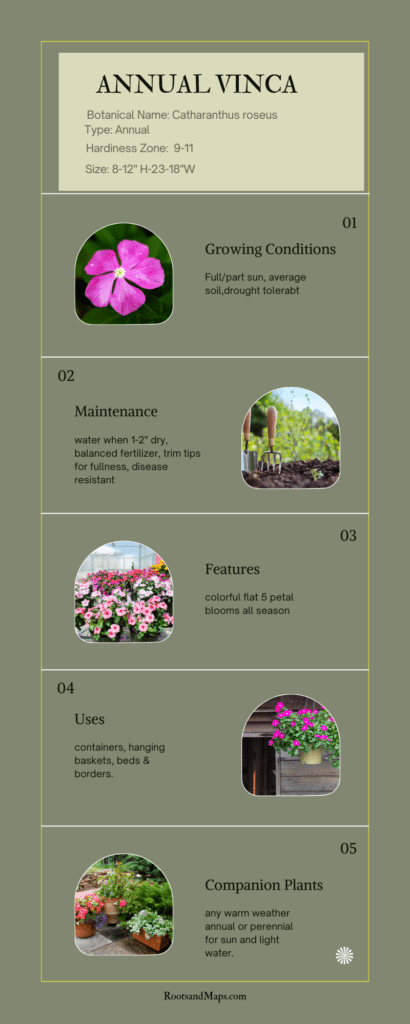
When to Find Vinca
Annual vinca is remarkably tolerant of heat and drought. If you are busy or forgetful, this is the flower for you! This means that you will see Vinca for sale as the days turn toward summer. In many climates, this will be from Mid May and June. In our South Florida subtropical climate, we see them slowly arriving about March.
The annual Vinca provides bright summer color, low maintenance, tolerance of poor soil, and is drought-resistant! On hot days you can look at them from a shady hammock. There is not much work to do. The blossoms are profuse and come in many colors and even patterns. Annual Vinca is not the perennial ground cover, also called vinca or periwinkle.
Annual Vinca-Bright Colors
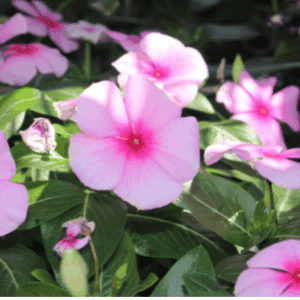
This is Catharanthus roseus, it is taller, and you will often see the characteristic colored “eye.” The eye is often in different colors creating a patterned effect.
New Colors
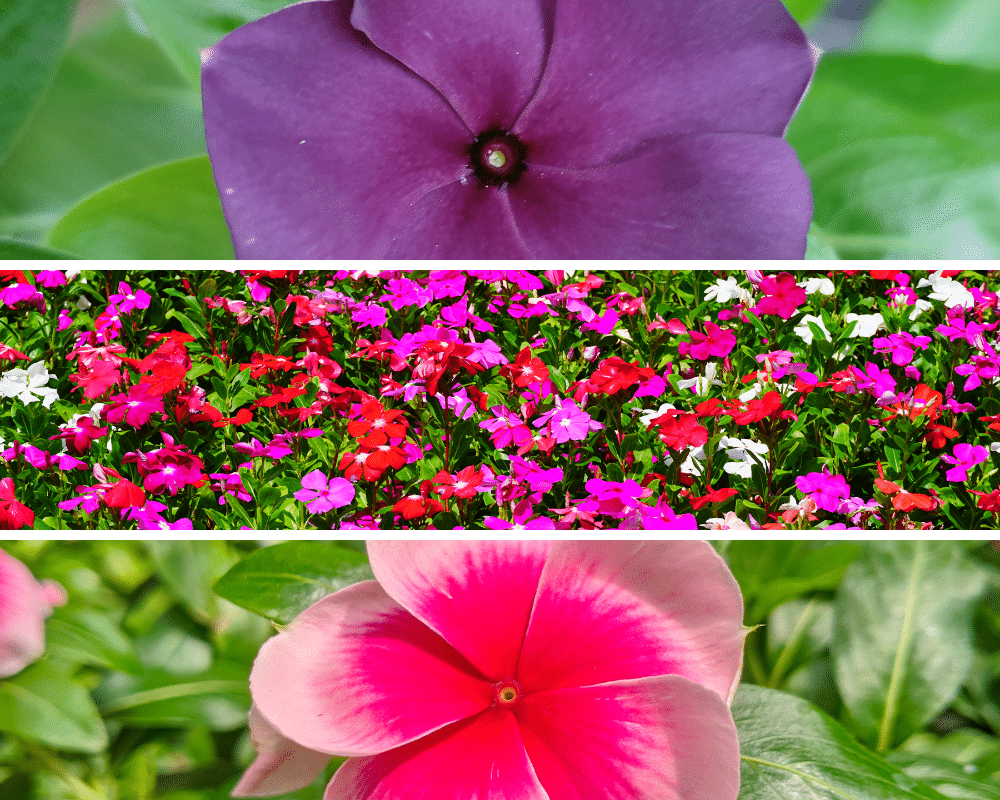
Vinca has long been considered a source of pale, pastel flowers. This produced containers and beds that were pretty but limited.
Consider those days over; there are darker and more vivid colors and combinations available today.
In addition, new varieties are producing more flowers per plant.
Africa’s Gift Loves The Heat
Some people call vinca “Africa’s gift to the world” because it is beautiful, useful, easy to live with, and has medicinal benefits too!
Discovered on Madagascar, a challenging climate for many plants and the world’s 4th largest island. Vinca was first named by Carl Linnaeus and later reclassified to its current genus and species in the 19th century.
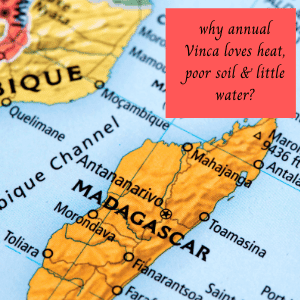
In the hot summer, this mounding annual offers a bold and vivid display just when other color plants are drooping. They are not flawless, but they are easy and fun to see in the garden. In our South Florida garden, they last longer than a year. If your summers get hot and you need color for a bright, sunny spot, this plant will bloom vigorously when many other options will fail.
Don’t Be Fooled By Confusing Names
This is one of many plants with a confusing number of names. This plant is Catharanthus roseus. It is in the dogbane family, and it’s called Vinca, periwinkle, old maid, bright eyes, it goes on.
Annual Vinca vs Vinca Minor
Our annual vinca is commonly confused with Vinca minor, also called periwinkle. This one is the blue-flowered, periwinkle ground cover that is great for controlling steep slopes. Same family (Apocynaceae-dogbane), a different genus. When a plant has a specific epithet or species called minor, you can expect it to be a smaller relative. It is, however, only the names that are confusing; the plants do not look similar.
Vinca major
Vinca major is a larger version of the Vinca minor; it is also a trailing vine that spreads across the ground and roots along the stems to act as a ground cover. The flowers are found in blue and occasionally white, and the foliage is green or variegated. It is used as a groundcover and in parts of the world, is invasive.
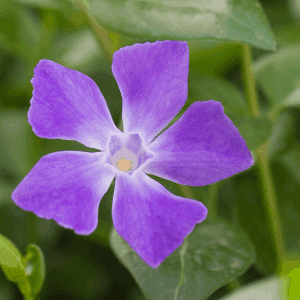
This is Vinca minor or periwinkle. Note the pinwheel-shaped flower, the characteristic shade of blue, and the densely packed, bright green leaves. The plant is also the lowest-growing plant and is the only perennial in the group.
Is Vinca-Catharanthus roseus An Annual Or A Perennial?
Like many of the plants we call annual and often treated as such, our vinca is actually a tropical perennial, unable to accept cold. In zones 9-11, it is a shorter-lived perennial. In colder climates-zones 2-8, it is an annual. In cool climates, to get maximum use from the plant put it in the ground at the same time you plant tomatoes. It should provide color in your garden with minimum maintenance from mid-spring to the first freeze in your area.
Details of the Flower
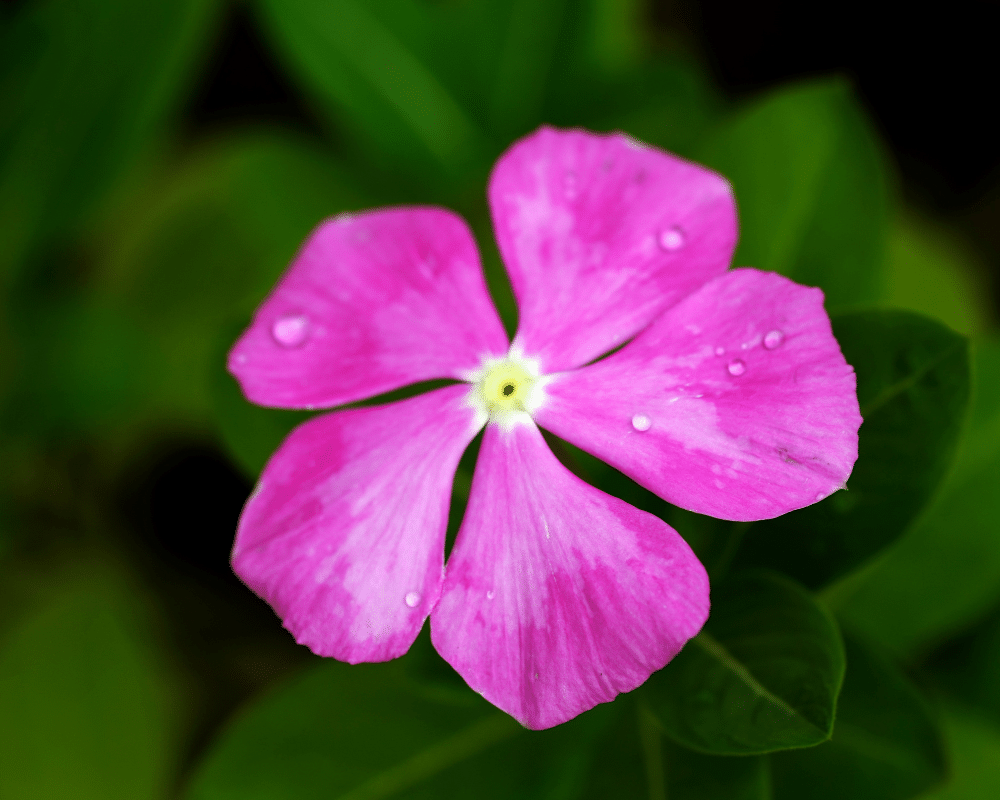
Here is the Vinca blossom; it has five flat petals, and it can appear as one color (look primarily for versions of red, pink, lavender, and white). It also often appears with a center of a different color, and some have edges of a different shade.
The petals are close together and can overlap.
Low Maintenance
Vinca is a low-maintenance source of color for the garden. The photo is an interesting comment on “low” maintenance. We planted Vinca in a hanging basket which we enjoyed. Seeds dropped to the ground. Too indolent to pick up the tiny plants, I left them. This large healthy patch of blooms is the result!
This is what happens when the seeds drop.
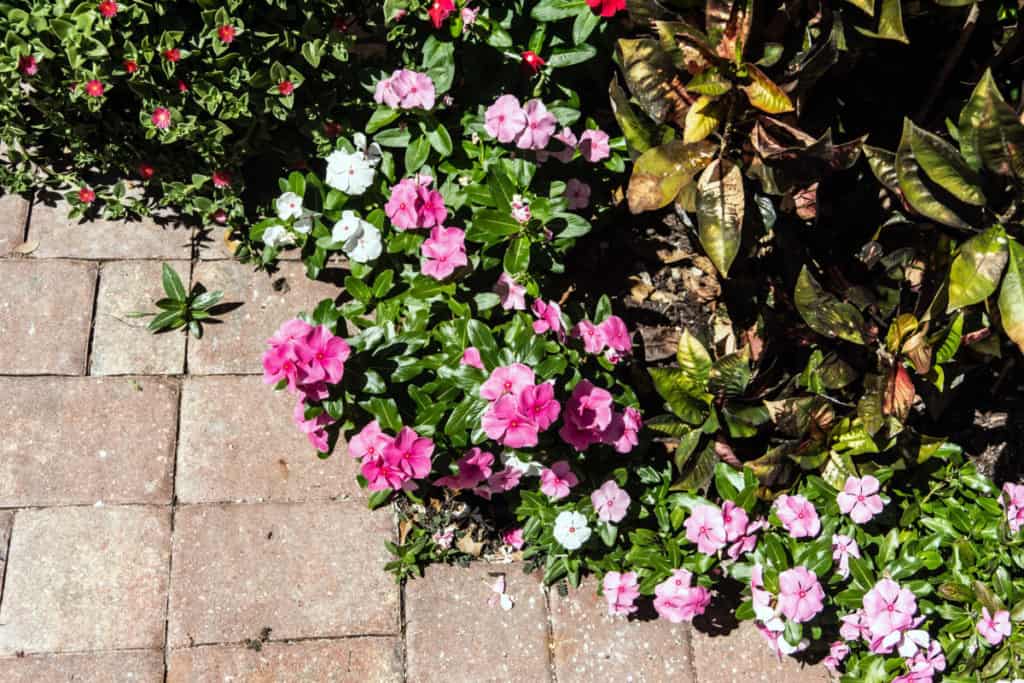
How Can I Use Annual Vinca’s Bright Colors?
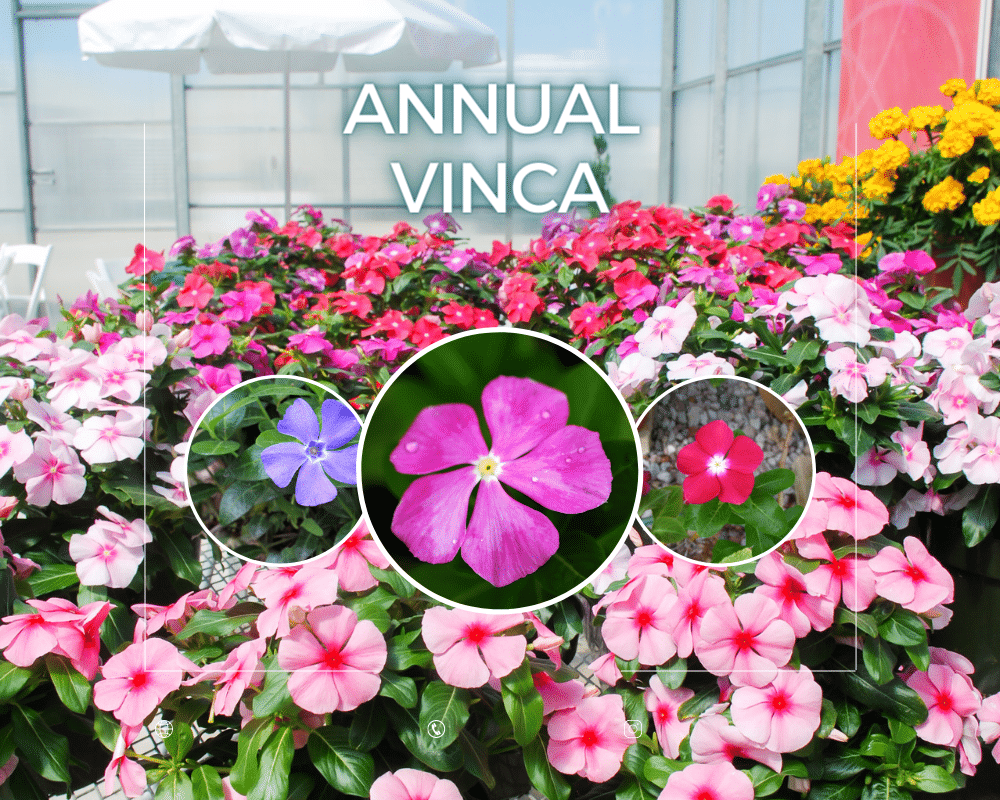
Remember that flowering Vinca originates in hot, arid Madagasgar. Color choices are many; look for pink, white, purple, red, magenta, and lavender. Some are bicolor, and some are called polka dots due to a center of a second bright color. These are old cultivars, around since the 1920s, and their popularity encourages the creation of new varieties. Look out for new ones.
Size and Shape-How Far Can Annual Vinca Spread?
How to use them:
There are two forms of this plant, Upright, about 15″ high and wide. The second is Trailing; some varieties can reach 36″ wide, and they are lower than the upright version. The trailing version is superior in hanging baskets and containers. On the ground, it covers a considerable territory with color and for a modest price.
Where And When Can I Use Vinca?
- Beds
- Borders
- Containers
- Hanging baskets
- Window boxes
- To create a bright ground line in front of a wall or hedge
Plant Vinca in spring after you expect the soil temperature to be 70 degrees. A cooking thermometer works just fine to test your soil. In colder climates, this would be about the first of May. In zone 10 in South Florida, we start to plant them in about March. In large plantings for our community, we use Vinca as a popular summer option.
They are suitable for full sun or part sun. Vinca will perform in morning sun, but as shade continues, the plant will produce fewer blossoms and appear less full.
Vinca is a low-maintenance plant; the one critical feature to provide is good drainage. If you think your soil drains poorly, you can amend it with organic matter, peat, and sand. This is how to measure your drainage. This is about different types of soil and how they can be improved. If your soil does not drain, you can add organic matter or use them in containers or raised beds.
Vinca in Containers
Vinca makes a fine container plant and pairs well with other annuals (see below for popular companions). Water when the top one to two inches of soil are dry and ensure good drainage. To do this, use well-draining potting soil and ensure that the container has drainage holes.
Vinca vs. Impatiens
Sometimes these two are confused. They are similar in size and flower shape. The leaves are similar, and they serve the same purpose. The important differences are these: Vinca thrives in heat, hot and dry, or hot and humid. Impatiens will tend to wilt after extended periods of heat. Rabbits may find the impatiens tasty. Not so the Vinca. Vinca leaves are smooth on the edge. Impatiens have a leaf with a serrated edge.
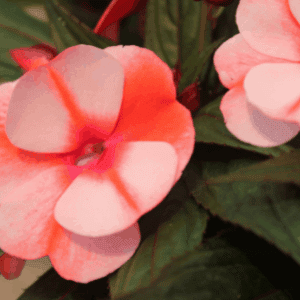
Here is Impatiens walleriana; it is available in a wide variety of interesting and often subtle colors, and the leaves of most are glossy. Note the serrated edge of the foliage.
While Vinca has a nice variety of colors to offer, Impatiens has more. We in zone 10b like to use impatiens in the winter and enjoy them as long as we can in summer. The Vinca can last several years. In a zone a little north of ours, we could keep Impatiens for several years.
Some Helpful Varieties Of Vinca
As a popular plant, vinca includes many cultivars. Cultivars are man-made varieties of plants. In plants like vinca that are easy to grow, you can expect to see a pretty steady stream of new varieties.
Here are some examples. These are branded trade names given to the plants. You will see them labeled in the garden center. In South Florida, I’ll be seeing lots of them all summer and winter. In colder climates, look for them in spring.
- Cora Apricot
- Cora Red
- Cora White
- Cora Cascade Magenta
- Cora Cascade Strawberry
- Soiree Double White
- Soiree Kawaii Coral
- Soiree Kawaii Lavender
- Soiree Kawaii Pink Peppermint
- Soiree Kawaii Pink
- Valiant Apricot
- Valiant Burgundy
- Valiant Lilac
- Valiant Orchid
- Cataranthus roseus Pacific, this series has several colors and is tall at about 2′. The flower is large, and the petals overlap. You will find colors including white, pink, rose, and light lavender, and the first true red found in Vinca. If you need height, this might be the one for you.
- Mediterranean Series-I know of lavender and white; they are very low at only 6″ high and are trailing, ideal for training from tall containers and hanging baskets.
How To Plant Vinca
You will buy smaller plants, ready to grow in the ground. Dig a hole about twice the size of your new plant and as deep as the pot. You can lighten your soil with a potting mixture. Carefully take the plant from the pot. You can cut the pot or squeeze it to cautiously remove the young plant. Annuals normally do not need the roots separated. You can gently massage the root area to loosen the root. Plant in the ground or container with the top of the plant slightly above the soil line. Water the plants as you put them in the ground.
Vinca is drought-resistant once established. Put your finger in the ground, and when it is dry, about an inch down, add water. Add water-soluble fertilizer to the plants monthly during the bloom period. Follow the instructions on the fertilizer box.
Planting Vinca in Containers
Always take steps to ensure good drainage. Containers tend to produce very good drainage. In hanging baskets, ensure that some large pieces of mulch or other draining materials are near the bottom to ensure drainage. Hanging baskets need to be watered every day in summer. Water until it drains out the bottom. How to choose potting soil might be helpful.
The new cultivars of Vinca should not need deadheading.
Pruning
You can maximize your blooms by cutting off dead or broken branches and the tips of the branches. Vinca blooms on new growth, and if you have time to do this about every 10-15 days it does seem to increase the blooms.
Pollinators And Wildlife
Vinca-Catharantheus roseus– is a member of the Dogbane family and has its characteristic milky, latex sap. (This is the toxic sap found in Milkweed that prevents birds from eating the Monarch butterfly caterpillars.)
This means that while butterflies will be attracted to your vinca flowers, deer and rabbits will not be interested.
Pests And Diseases
Vinca, popular for decades, developed a problem with fungus a few years ago. It became a serious issue, and eventually, new cultivars resistant to disease were developed. Two varieties that are resistant are Cora and Nirvana. Each is available in both varieties, upright and cascading. The cascading variety covers 36″ with large blossoms in many colors. Colors in Cora include Cherry, Lilac, and Magenta. Peach, Periwinkle, and Polka dot.
Vinca Cora XDR
This is a new variety and is considered the most disease resistant. We used over 1600 for community planting, and they performed well in our humid summers.
Fungal Disease
The problem is aerial Phytophthora fungus. It exists in soil and can splash on the plant in rain or from overhead watering. The pathogen appears during periods of warm and wet weather, and during periods of extended rain, it can spread rapidly from plant to plant.
In wet periods inspect the plants for lesions on the foliage or black spots that look like sooty mold and on the base of the affected shoots. Sometimes parts of the same plant will appear damaged, and the rest of the plant appears unaffected.
If you see signs of fungus, remove the entire plant and destroy it, including the roots.
It is the only serious problem with Vinca, and the solution seems to be to plant only varieties resistant to the fungus.
Good Companion Plants For Vinca
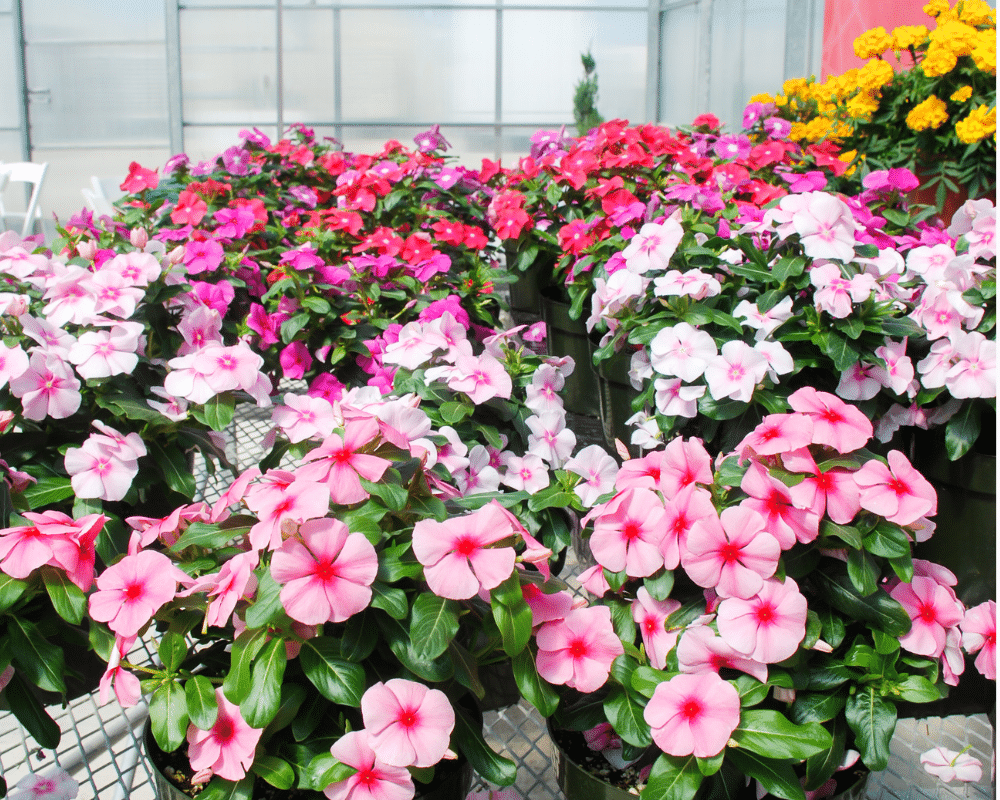
Pair the vinca with other plants that like the same conditions. I am looking at an image consisting of blue salvia in the back, then magenta vinca and zinnia. An attractive and simple display. Other choices are moss rose, lantana, million bells, sweet potato vines, or angelonia.
Often Vinca includes a center dot of a color different than the rest of the flower. It can be fun to match that dot color to that of another flower. Perhaps a burgundy dot with burgundy coleus?
Look in your garden center; this simple flower, with sometimes two or three colors, will give you some good ideas for planters or beds at your house.
More Annual Bedding Plants
These plants should be available to you at the same time as Vinca. For a cooler weather annual or one for a shade location, look at Impatiens, as the plant appearance is similar. (You will find three major categories, the original Impatiens walleriana is the most shade tolerant.)
Angelonia-spire shaped
-trailing with tiny blooms
Begonia-color
Calibrachoa-like small petunias
This is ornamental salvia. It adds height and a new shape to your beds of vinca.
Impatiens.
